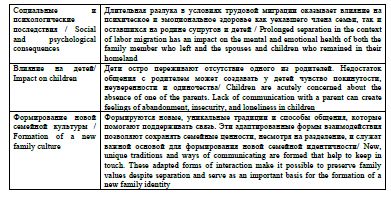Transnational families in the context of labor migration: transformation of family roles and dynamics of interaction
The increase in the scale of labor migration leads to an increase in the number of transnational families, in which the physical separation of spouses causes significant changes in the dynamics of interaction, the distribution of roles and traditional structures. The relevance of this study lies in the fact that such changes have a serious impact on the social and psychological well-being of family members, which requires the development of new forms of support and adaptation for migrants and their families. The scientific problem of the study lies in the in-depth analysis of the transformation of gender roles and family dynamics in the context of labor migration. The purpose of the article is to study the impact of labor migration on changes in family dynamics, with an emphasis on the change in the roles of spouses, the peculiarities of raising children, and the social consequences of separation. The novelty of the research lies in the interdisciplinary approach to the study of transnational families, focusing on the transformation of family dynamics, changes in the traditional roles of spouses and new forms of interaction that are formed as a result of the response to the long-term separation of the family. Methods. The study is based on the data of the author's sociological survey, as well as a secondary analysis of Russian and foreign studies. An interdisciplinary methodology is used, including qualitative and quantitative methods of analysis. Research results. The study revealed significant changes in the distribution of family roles. Most often, women who remain in their homeland take on the responsibilities of the head of the family, managing finances and raising children. Male migrants, in turn, become distant parents, whose role is limited to remittances and virtual support. Families are actively using modern technology to maintain emotional connection, creating new forms of communication. The significance of the study lies not only in identifying new aspects of the transformation of family dynamics, but also in formulating recommendations for the development of effective practical assistance to migrants and their families at the level of state and non-governmental structures.
Figures


Ledeneva, V. Yu. (2025), “Transnational families in the context of labor migration: transformation of family roles and dynamics of interaction”, Research Result. Sociology and Management, 11 (1), 147-160,
DOI: 10.18413/2408-9338-2025-11-1-1-0.


















While nobody left any comments to this publication.
You can be first.
Abashin, S. (2012), “Central Asian migration: practices, local communities, transnationalism”, Etnograficheskoe obozrenie, (4), 10. (In Russian)
Borisova, E. (2016), “Parenting at a distance: transnational practices in Tajik migrant families”, Antropologicheskiy forum, (28), 228-245. (In Russian)
Brednikova, O., Tkach, O. (2010), “A home for the nomad”, Laboratorium, (3), 73. (In Russian)
Zabrodskaya, A., Meir, N., Karpava, S., Ringblom, N., Ritter, A. (2023), “Family language policy in multilingual families during the COVID-19 pandemic: data from Cyprus, Estonia, Germany, Israel, and Sweden”, Yazyki, 8, 263, DOI: 10.3390/languages8040263. (In Russian)
Christensen, P. S. (2020), “Rethinking the importance of distance in the lives of multinational families: how and why Danish migrant parents pass on “Danishness” to their children who have settled in Australia”, Nord. J. Migrat. Res., (10), 34-50, DOI: 10.2478/njmr-2019-0025. (In Russian)
Levandovskaya, E. N., Pryakhina, A. V. (2015), “On the concept of hybridization in national-cultural identity research: problems and perspectives”, Observatoriya kultury, (5), 4-9. (In Russian)
Ledeneva, V. Y. (2022) Sociological dimension of social adaptation of labor migrants: regional aspect, Bulletin of the South Russian State Technical University (NPI). Series: Socio-Economic Sciences. 15 (4), 106-119, DOI: 10.17213/2075-2067-2022-4-106-119. (In Russian)
Ledeneva, V. Yu., Mishchuk, S. N. (2023), “Family and business activity of women immigrants in Russia”, Uroven zhizni naseleniya regionov Rossii, 19 (1), 25-35, DOI: 10.52180/1999-9836_2023_19_1_2_25_35. (In Russian)
Merla, L., Kilkey, M., Wilding, R., Baldassar, L. (2021), “Chapter 27: Key developments and perspectives in the study of transnational families”, Spravochnik po sotsiologii sem’i [Handbook of Family Sociology], Edward Elgar Publishing, Cheltenham. (In Russian)
Nedelku, M., Fernandez, G. G., & Wyss, M. (2023), “A configurational approach to transnational families: who and where is a family member in the case of mobile seniors?”, Glob. Netw, 24, DOI: 10.1111/glob.12466. (In Russian)
Osadchaya, G. I., Yudina, T. N., Kocherbaeva, A. A. (2023), “Reproductive behavior of migrants from Central Asia in the Moscow agglomeration”, DEMIS. Demograficheskie issledovaniya, 3 (4), 78-91, DOI: 10.19181/demis.2023.3.4.5. (In Russian)
Peshkova, V. (2022), “Project card for fundamental and exploratory scientific research supported by the Russian science foundation, [Online], available at: https://rscf.ru/project/22-18-00377/. (Accessed 10 October 2024). (In Russian)
Peshkova, V. M. (2016), “Transnational features of family economy of labor migrants from Central Asia in Russia”, Monitoring obshhestvennogo mneniya: Jekonomicheskie i social'nye peremeny, (1), 240-255. (In Russian)
Tolmacheva, A. Y. (2022), “Families of migrants from Post-Soviet States: between the Motherland and Russia”, Vestnik Instituta sotsiologii, 13 (3), 49-69, DOI: 10.19181/vis.2022.13.3.830 (In Russian)
Harris, A., Baldassare, L., Robertson. S. (2020), “Rooted in time and space? Changing
intimate relationships in the migration process and the life path of mobile young people”, Population, Space and Place, 26, DOI: 10.1002/psp.2357. (In Russian)
Shevchenko, I. O. (2016), “Transnational parenthood: research and problems”, Vestnik RGGU. Seriya: Filosofiya. Sotsiologiya. Iskusstvovedenie, (2), 84-91. (In Russian)
Erlinghagen, M. (2021), “Transnational life cycle: an integrated and unified theoretical framework for migration research”, Ethn. Racial Stud., 44, 1337-1364, DOI: 10.1080/01419870.2021.1880014. (In Russian)
Baldassar L. (2008), “Missing kin and longing to be together: emotions and the construction of co-presence in transnational relationships”, Journal of Intercultural Studies, 29, 247-266, DOI: 10.1080/07256860802169196.
Levitt, P., Glick Schiller, N. (2004), “Conceptualizing simultaneity: a transnational social field perspective on society”, International Migration Review, 38 (3), 1002-1039, DOI: 10.1111/j.1747-7379.2004.tb00227.x.
Levitt, P., Jaworsky, B. N. (2007), “Transnational migration studies: past developments and future trends”, Annual Review of Sociology, 33, 133.
Ngan, L. L. S., & Chan, A. K. W. (2021), “Transnational familyhood and migration strategies among parachute kids-turned-parents from Hong Kong”, Asian Studies Review, 46(2), 197-214, DOI: 10.1080/10357823.2021.1937939.
Ngan, L. L. S., Chan, A. K. U. (2022). Transnational Family Arrangements and Migration Strategies among Parachute Kids Turned Parents from Hong Kong. Asian Studies Review, 46, 197-214, DOI: 10.1080/10357823.2021.1937939.
Parreñas, R. S. (2008), “Transnational fathering: gendered conflicts, distant disciplining and emotional gaps”, Journal of Ethnic and Migration Studies, 34 (7), 1057-1072.
Portes, A., Guarnizo, L., Landolt, P. (1999), “The study of transnationalism: pitfalls and promise of an emergent research field”, Ethnic and Racial Studies, 22 (2).
Schiller, N., Basch, L., Szanton Blanc, C. (1995), “From immigrant to transmigrant: theorizing transnational migration”, Anthropological Quarterly, 68, 48-63, DOI: 10.2307/3317464.